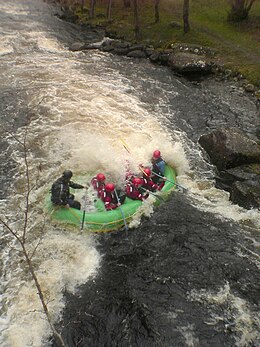
Back قفزة مائية Arabic Hidravlik sıçrayış Azerbaijani Гідраўлічны скачок Byelorussian Vodní skok Czech Wechselsprung German Salto hidráulico Spanish پرش هیدرولیکی Persian Ressaut hydraulique French זנק הידראולי HE Hidraulički skok Croatian

A hydraulic jump is a phenomenon in the science of hydraulics which is frequently observed in open channel flow such as rivers and spillways. When liquid at high velocity discharges into a zone of lower velocity, a rather abrupt rise occurs in the liquid surface. The rapidly flowing liquid is abruptly slowed and increases in height, converting some of the flow's initial kinetic energy into an increase in potential energy, with some energy irreversibly lost through turbulence to heat. In an open channel flow, this manifests as the fast flow rapidly slowing and piling up on top of itself similar to how a shockwave forms.
It was first observed and documented by Leonardo da Vinci in the 1500s.[1] The mathematics were first described by Giorgio Bidone of Turin University when he published a paper in 1820 called Experiences sur le remou et sur la propagation des ondes.[2]
The phenomenon is dependent upon the initial fluid speed. If the initial speed of the fluid is below the critical speed, then no jump is possible. For initial flow speeds which are not significantly above the critical speed, the transition appears as an undulating wave. As the initial flow speed increases further, the transition becomes more abrupt, until at high enough speeds, the transition front will break and curl back upon itself. When this happens, the jump can be accompanied by violent turbulence, eddying, air entrainment, and surface undulations, or waves.
There are two main manifestations of hydraulic jumps and historically different terminology has been used for each. However, the mechanisms behind them are similar because they are simply variations of each other seen from different frames of reference, and so the physics and analysis techniques can be used for both types.
The different manifestations are:
- The stationary hydraulic jump – rapidly flowing water transitions in a stationary jump to slowly moving water as shown in Figures 1 and 2.
- The tidal bore – a wall or undulating wave of water moves upstream against water flowing downstream as shown in Figures 3 and 4. If one considers a frame of reference which moves along with the wave front, then the wave front is stationary relative to the frame and has the same essential behavior as the stationary jump.
A related case is a cascade – a wall or undulating wave of water moves downstream overtaking a shallower downstream flow of water as shown in Figure 5. If considered from a frame of reference which moves with the wave front, this is amenable to the same analysis as a stationary jump.

These phenomena are addressed in an extensive literature from a number of technical viewpoints.[3][4][5][6][7][8][9][10][11][12][13][14][15][16][17][18]
Hydraulic Jump is used sometimes in mixing chemicals.[19]
- ^ "Household phenomenon observed by Leonardo da Vinci finally explained". Retrieved 2018-08-08.
- ^ Cabrera, Enrique (2010). Water Engineering and Management through Time: Learning from History. CRC Press. ISBN 978-0415480024.
- ^ Douglas, J.F.; Gasiorek, J.M.; Swaffield, J.A. (2001). Fluid Mechanics (4th ed.). Essex: Prentice Hall. ISBN 978-0-582-41476-1.
- ^ Faber, T.E. (1995). Fluid Dynamics for Physicists. Cambridge: Cambridge University Press. ISBN 978-0-521-42969-6.
- ^ Faulkner, L.L. (2000). Practical Fluid Mechanics for Engineering Applications. Basil, Switzerland: Marcel Dekker AG. ISBN 978-0-8247-9575-7.
- ^ Fox, R.W.; McDonald, A.T. (1985). Introduction to Fluid Mechanics. John Wiley & Sons. ISBN 978-0-471-88598-6.
- ^ Hager, Willi H. (1995). Energy Dissipaters and Hydraulic Jump. Dordrecht: Kluwer Academic Publishers. ISBN 978-90-5410-198-7.
- ^ Khatsuria, R.M. (2005). Hydraulics of Spillways and Energy Dissipaters. New York: Marcel Dekker. ISBN 978-0-8247-5789-2.
- ^ Lighthill, James (1978). Waves in Fluids. Cambridge: Cambridge University Press. ISBN 978-0-521-29233-7.
- ^ Roberson, J.A.; Crowe, C.T (1990). Engineering Fluid Mechanics. Boston: Houghton Mifflin Company. ISBN 978-0-395-38124-3.
- ^ Streeter, V.L.; Wylie, E.B. (1979). Fluid Mechanics. New York: McGraw-Hill Book Company. ISBN 978-0-07-062232-6.
- ^ Vennard, John K. (1963). Elementary Fluid Mechanics (4th ed.). New York: John Wiley & Sons.
- ^ Vischer, D.L.; Hager, W.H. (1995). Energy Dissipaters. Rotterdam: A.A. Balkema. ISBN 978-0-8247-5789-2.
- ^ White, Frank M. (1986). Fluid Mechanics. McGraw Hill, Inc. ISBN 978-0-07-069673-0.
- ^ Chanson, H. (2004). The Hydraulic of Open Channel Flow: an Introduction (2nd ed.). Butterworth-Heinemann. ISBN 978-0-7506-5978-9.
- ^ Chanson, H. (2009). "Current Knowledge In Hydraulic Jumps And Related Phenomena. A Survey of Experimental Results" (PDF). European Journal of Mechanics B. 28 (2): 191–210. Bibcode:2009EJMF...28..191C. doi:10.1016/j.euromechflu.2008.06.004.
- ^ Murzyn, F.; Chanson, H. (2009). "Free-Surface Fluctuations in Hydraulic Jumps: Experimental Observations". Experimental Thermal and Fluid Science. 33 (7): 1055–1064. doi:10.1016/j.expthermflusci.2009.06.003.
- ^ Chanson, Hubert (April 2012). "Momentum Considerations in Hydraulic Jumps and Bores" (PDF). Journal of Irrigation and Drainage Engineering. 138 (4): 382–385. doi:10.1061/(ASCE)IR.1943-4774.0000409.
- ^ "Hydraulic Jump -Types and Characteristics of Hydraulic Jump". The Constructor. 2016-06-17. Retrieved 2019-12-26.
© MMXXIII Rich X Search. We shall prevail. All rights reserved. Rich X Search